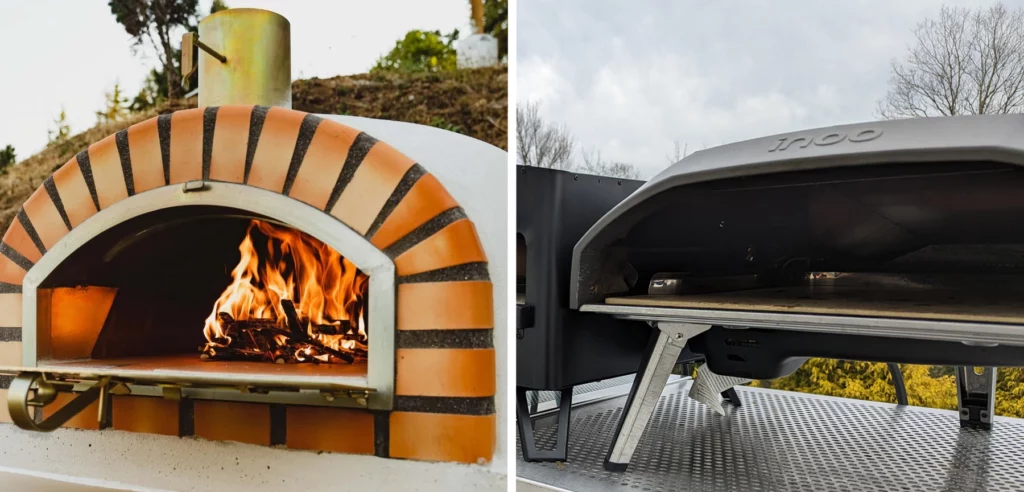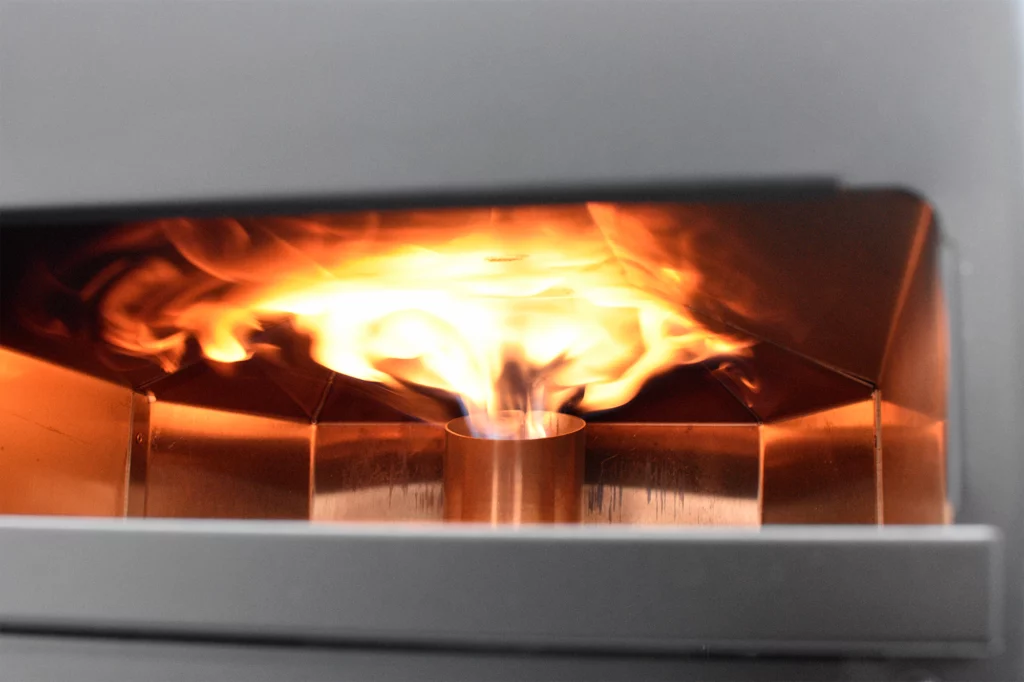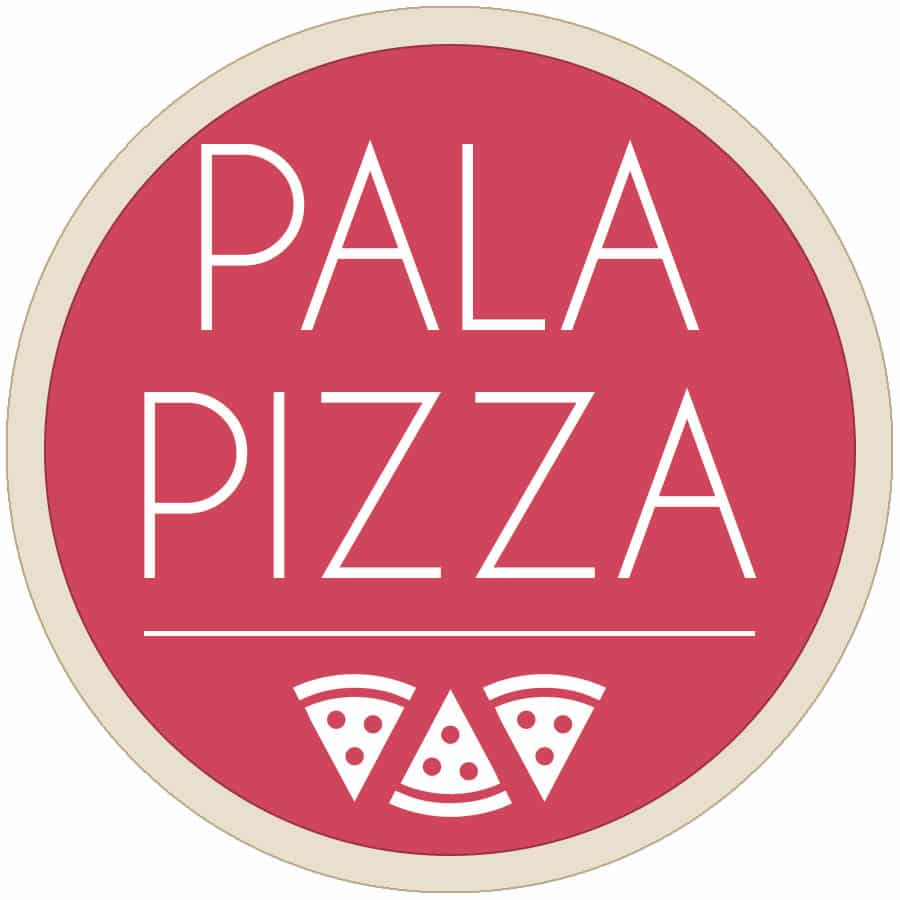Are you considering getting an outdoor pizza oven but don’t know which style to go for? Maybe you’re unsure about the differences between portable pizza ovens and DIY brick ovens? You’ve come to the right place. We look at the main similarities and differences between these two styles of backyard pizza ovens so that you can figure out which one will work best for you.
Bear in mind that one style of oven is not necessarily better than the other. But they do have different features, which might mean one will suit your needs better than the other.
So we’ll look at the differences in appearance, size, functionality, price, and more, to help you make an informed choice between portable pizza ovens and DIY or built-in brick ovens.
Let’s dive in.
At A Glance
Portable Pizza Ovens
- More affordable
- More lightweight and maneuverable
- Offer a choice of fuels
- Far less labor involved
- Much faster preheat times
DIY Brick Ovens
- More expensive
- Larger and heavier
- A permanent feature of your home and backyard
- Create authentic wood-fired pizzas
- Take time to build, cure, and preheat
Appearance
There are plenty of differences between these two styles of ovens regarding size, weight, style, and the materials used.

Style
DIY brick ovens tend to have a rustic appearance created by the neutral tones and the materials used. This can make the oven a stylish backyard feature and help create a cool space to hang out and socialize while cooking.
Portable ovens tend to have a more modern look that can make them seem more like an appliance than a design feature. Manufacturers tend to favor stainless steel and chrome finishes rather than natural shades.
Although, there are some portable ovens with a more neutral finish, like The Gozney Dome with its bone-white casing. Or you can choose to celebrate the modern look with something like an Alfa Moderno, which comes in bright red or yellow.
Also, some people choose to liven up their brick ovens by setting mosaic tiles or colorful designs on the outside of the dome. So chances are high that you can find, or build, an oven to suit your personal style.
Materials
DIY brick ovens are made using bricks, clay, and concrete. When constructed correctly, they replicate the brick ovens used in the restaurants of Naples to create the authentic Neapolitan pizza we love so much. The oven can reach and maintain super-high temperatures creating the perfect environment for cooking delicious pizza.
Most portable pizza oven manufacturers strive to recreate these cooking conditions using lighter, more affordable materials such as ceramic pizza stones and stainless steel domes. And many portable ovens on the market today come very close to recreating that authentic brick oven environment. Some would even argue that they’ve surpassed it to create a more efficient pizza-cooking method (but that is up for debate).
Assembly
This is one of the most significant differences between these two pizza styles. You can have a portable pizza oven delivered to you in a matter of hours, and most of them arrive almost completely assembled. You are required to do little in the way of construction other than maybe sliding the doors and fuel trays into place and affixing a chimney. You’re then able to start cooking pizzas immediately.
On the other hand, constructing a DIY brick oven is a project that takes much more time and effort. Building a brick oven can take you anywhere between a weekend and a week’s worth of work, depending on the scope of your project and your skills. Brick ovens must also be cured properly before they can be used to prevent the materials from cracking or breaking. This process adds several more days onto the project.
You have some options when it comes to building your own oven:
You can build the oven from scratch using materials from your local hardware store. Thanks to the popularity of these ovens, you can find plenty of help online, from how-to guides to video tutorials to forums discussing tried and tested methods.
Or you can purchase a brick oven kit from a manufacturer. This will contain all the necessary elements to build the oven, including materials, tools, and instructions. This option tends to cost a lot more but is undoubtedly more efficient and cuts down the risk of error.
A third option is to hire a contractor to do all or part of the work for you. Again this will increase the cost of your build but should cut down the time taken and reduce the margin for error so long as you hire someone who knows what they’re doing.
None of these options is inherently better than the others. It comes down to your personal preference. Ask yourself whether you’d enjoy the process of building the oven, how much time and money you have to spare, and whether you’d rather just have an oven up and running immediately.
Size, weight, and portability
The term ‘portable pizza oven’ can be a little confusing because it covers all sizes of ovens, from compact stoves like the Ooni Fyra, which weighs only 22lbs and is perfect for camping trips, to large ones like the 24″ Forno Venetzia Pronto, which weighs over 100kgs and would be a semi-permanent feature of your back yard.
These larger, heavier ovens are not portable in the sense that you can take them to a cookout. But you can mount them on a wheeled trolley to move them around your garden and take them with you when you move house.
In comparison, DIY or built-in brick ovens are even heavier and not at all portable. They are too heavy to be mounted on a trolley and need a reinforced stand of concrete and blocks. As a result, they’re a permanent construction and not a great option if you plan on relocating soon.
Brick ovens also tend to be larger than portable ovens. Since you’re not planning to move them, they can be built as large and heavy as you like and so tend to have a larger cooking capacity than portable ovens. The stand, chimney, and thickly insulated dome all add to the size of the oven, too, so make sure you’ve got plenty of space before you construct. And remember that you want plenty of space around it to stand, prep, cook, and socialize.
Functionality
There’s no use choosing a pizza oven based on what it looks like alone. You need to know how it works! And there are some clear differences in how portable and brick ovens function.

Fuel
One of the biggest divides in the pizza-making world is caused by the fuel chefs use to make their perfect pizza. Wood and gas are the most common choices, although you’ll find ovens using charcoal or even electric, like the recently released Ooni Volt. Each fuel has its pros and cons, and when it comes to choosing which style of pizza oven you’re going to purchase, fuel choice is an important consideration.
Put simply, gas is more convenient than wood, but wood is more authentic. DIY brick ovens are typically wood-fired, which will appeal to the traditionalists out there, while portable ovens offer a wider range of fuel choices. You can opt for a portable oven that uses wood pellets (super convenient for camping or small spaces), electric (great for indoor cooking), wood (for the authentic smokey flavour), or gas (for minimal prep and clean up). And you can purchase a growing number of portable ovens that offer a dual option, ideal for chefs who enjoy creating both wood and gas-fired pizza.
So, unless you’re fully committed to wood-fired pizza, you might want to consider the portable options.
Features
Portable pizza ovens tend to come with more features than brick ovens. This is because manufacturers of portable ovens are constantly innovating, coming up with new ideas and fresh features to improve the pizza-making experience. Whereas, a large part of the brick oven’s appeal is that it hasn’t changed for centuries.
Portable ovens can come with handy features like a built-in temperature gauge, easy ignition switch, dual burners, removable pizza stone, or a digital thermometer. Plus, many of them can be modified with accessories like a dual fuel adaptor, steam injector, or smoker. All of these features are designed to make it easier to cook the perfect pizza and increase your oven’s versatility.
Some people will find these features helpful, maybe even essential, while others find them unnecessary and prefer the simplicity of the DIY brick oven.
Cooking capacity
Generally, portable ovens are smaller than brick, especially those designed to be truly portable. You can find portable ovens barely bigger than a 10″ pizza, while no one would bother to build a brick oven that small.
If you want more space, both Ooni and Gozney’s largest ovens can comfortably cook 16″ pizzas, and you can find higher capacity in the large, less portable ovens offered by Forno Piombo and Alfa Fornio. However, you would have to spend a lot of money to get close to the cooking capacity of a brick oven.
Note: If you want to cook more than pizza, make sure to check the height capacity of your oven as well as the floor space. Make sure it can accommodate any roasting trays, skillets, and dishes you plan to use.
Cooking
Ok, time for the most important part, how well do these ovens compare when it comes to making pizza?

Preheating and heat retention
As a general rule, brick ovens take longer to heat up but can reach higher temperatures and retain their heat better and for longer than portable ovens.
Depending on the size of your brick oven, you can be looking at a preheat time of a couple of hours. This means you’ll never be making pizzas on a whim. You’ll need to plan in advance, which can take the fun out of it for some people. However, once you get a brick oven hot, it can easily maintain a high heat and retain its heat for hours. You can cook pizza after pizza all day long in a brick oven and then slow roast a joint of meat overnight with the residual heat.
In contrast, thanks to the modern materials and technology, you can find portable ovens with preheat times as fast as 15 minutes. Ideal for whipping up a last-minute dinner or feeding hungry kids. However, where many portable ovens struggle (the lower-end models especially) is the ability to retain heat between pizzas, so you may need to reheat the oven between bakes. This is something to consider if you plan to throw regular pizza parties.
Max heat
For a pizza oven to be effective and authentic, it needs to hit high temperatures of over 800°F but ideally closer to 950°F. A properly constructed brick oven will manage this with ease and be able to maintain that heat easily.
Some portable ovens can struggle to reach those high temperatures, but it shouldn’t be a problem for quality models. Make sure you read the specs and reviews before purchasing to ensure you’re choosing an oven that can reach the temperatures you need for perfect pizza.
Cooking time
Once you get a brick oven up to temperature, it can cook a perfect pizza in a minute or less. Portable ovens all strive to match that rapid cooking time, and some of our favorite models succeed. However, the lower-end and less powerful models do take a little longer.
Pizza quality
Followers of our blog and website will know that we love nothing more than a portable oven that can cook delicious pizza. And, through many hours of experimentation and testing, we’ve found plenty of portable ovens that are up to the challenge.
However, it’s a fact that the question we’re often asking during reviews is: ‘does this oven make pizza as good as an authentic brick oven?’
Because brick oven pizzas are the original deal, they are what’s served in your favorite restaurants, they’re what’s been created in the pizzerias of Naples for decades, and they are what most of us are trying to replicate in our backyards.
And honestly many of the portable pizza ovens do perform as well as a brick oven in terms of cooking performance, since they can reach the temperatures required by the AVPN. The difference comes in heat retention – brick ovens can retain heat a LOT better and as result, use less fuel to cook more pizzas. But for an average homeowner, that may not be a huge factor.
Cooking versatility
What if you want to cook more than just pizza? Well, both brick and portable ovens offer versatility once you know what you’re doing. With the exception of some of the smallest portable ovens, most can be used to bake bread and pastries, grill seafood or poultry, cook dishes in cast iron skillets, and roast trays of meat and vegetables.
This is also true of brick ovens, where the added capacity means you can roast whole joints of meat and full meals at once. Brick ovens’ heat retention and ability to maintain a steady temperature also make them ideal for slow-cooking stews, casseroles, and overnight roasts. Plus, you can turn a brick oven (and a wood-fired portable oven) into a smoker.
In fact, what limits the versatility of these ovens is not their abilities but yours. There’s not much you can’t cook in a brick oven or portable pizza oven once you figure out how. Wood-fired ovens are a little trickier because cooking with wood comes with a learning curve, but practice makes perfect!
Price
The all-important question – which style of oven is more expensive? Well, there is no simple answer, but the basic rule is that portable ovens are less expensive than DIY brick ovens.
Of course, there are portable ovens at all price levels, and you choose to could spend several thousand dollars on one. However, you don’t need to. You can buy a small portable pizza oven for a couple of hundred dollars and can take your pick of several high-quality models for less than $1000.
When it comes to a DIY brick oven, you’re looking at an average cost of around $1000, depending on the size of the oven, the materials used, and your skill level. The price will go up if you buy a brick oven kit or hire a contractor to help you with the build. However, this price can also decrease if you have the skills to do it all yourself and choose reasonably priced materials.
Note: You’ll find websites and guides promising that you can create a pizza oven for a few hundred dollars using found or ‘alternative’ materials. While we’re not saying this isn’t possible, we advise you to be cautious and research thoroughly to ensure you’re building something safe and fit for purpose. Remember that the materials need to withstand extremely high temperatures, and since you’ll be cooking food, you must be sure you’re not accidentally using hazardous materials.
Conclusion
Those are all the main points to consider when choosing between portable and DIY brick ovens, so what’s our conclusion? Well, if you were hoping for us to declare an outright winner, you’re out of luck. There isn’t a right or wrong choice. However, there should be a choice that’s better suited to your needs.
So with that in mind, we give you this advice:
Consider a DIY brick or built-in oven if:
- You love a project and/or have the skills to do it yourself
- You love truly authentic Neapolitan-style pizza
- You’re a fan of wood-fired cooking and slow roasting
- You’re not concerned about moving the oven one day
- You don’t mind waiting a while to get started
- You’re good at planning ahead for those long preheat times
And think about a portable pizza oven if:
- You’re on a budget
- You want more fuel options
- You want to take your oven camping, on road trips, and on cookouts
- You don’t need a huge cooking capacity
- You want super fast preheat times
- You have limited space, rent, or are likely to move house
Hopefully, that’s answered your questions, and you now know which style of oven is for you! If you still have questions, drop us a message, and we’ll try to help as best we can.
If you choose the portable pizza oven route, check out our guides and reviews to help you pick the perfect machine. And if you choose a DIY brick oven, check out our recipes so you’re prepared when the time comes for that first bake!

